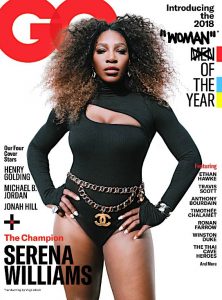Original Image:
In 2018, GQ announced Serena Williams as women of the year on the cover of its November edition. Shortly after its release, the magazine suddenly became embroiled in controversy. The reason? A pair of quotation marks around “woman.” Fans on Twitter and other media outlets were quick to voice their confusion and anger.

uh82cit wrote: “I can’t believe no one at GQ thought perhaps with misogynistic and violent trans insults that Serena (and Venus) have dealt with for the last almost 20 years, to not put woman in quotation marks. Editorial rooms are a fucking disaster, all over this country. I’m offended for her.”
Defenders of the artist, Virgil Abloh, who was responsible for the artistic direction for the handwriting, claim that the quotation marks were a well-known signature to his style, and that they did not mean to convey any sense of sarcasm or ambiguity. However, regardless of what the artist intended, the context around the person complicates the message’s interpretation.
Aside from quoting a person or a source, quotation marks can be used as scare quotes when they are used to question the verity of a person or thing. For example, the phrase, “Watch out! The ‘professor’ has arrived,” could be used to tease a person for being overly scholarly compared to their peers. The word “professor” is used in a mocking way, because everyone knows that the person is not actually a professor, and the quotations are being used to “imply skepticism or disagreement, belief that the words are misused, or that the writer intends a meaning opposite to the words enclosed in quotes” (Siegel, 1999).
Another common usage for scare quotes is in the context of transphobia. Questions such as “Is it a woman or a ‘woman’?” are unfortunately not uncommon to hear, and it is usually very clear that they are being said with ignorant and/or bigoted intents.
For Williams, these questions were not simply asked, but were turned into accusations in the form of conspiracy theories that circulated the Internet that she had been born a man and was keeping her “true” gender a secret from the world. For anyone aware of these attacks on Williams, seeing these score quotes around woman on the cover could easily be seen as adding fuel to the fire.
Jammed image and Jamming philosophy

For my jammed version of the ad, I decided to invert the use of quotation marks by removing them from the word woman, and putting them around “men” instead. In this way, the highlight returns to celebrating Williams and her accomplishments without the distraction of seeing the scare quotes, for reasons described above. By putting them instead around “men,” I hope to evoke similar feelings of confusion over why any gender should be inside score quotes, and hopefully draw attention to the latent transphobia that doing so elicits. In addition, I surrounded all the featured men on the cover with quotation marks as well, in order to acknowledge that the argument that quotation marks can be used as an artistic styling device, but also to highlight the bizarreness of seeing them in unexpected places.
References
CNN (November 14, 2018) https://www.cnn.com/2018/11/13/tennis/serena-williams-gq-controversy-spt-intl/index.html Accessed June 26, 1019.
Moran, Lee (November 13, 2018). “Serena Williams’ GQ ‘Woman Of The Year’ Cover Sparks Controversy.” Huffington Post. https://www.huffingtonpost.ca/entry/serena-williams-gq-woman-of-the-year_n_5beaaa0fe4b0caeec2bd8656 Accessed June 26, 2019.
Williams, Serena (2018) “Letter to my mom.” 2018. Reddit. https://www.reddit.com/user/serenawilliams/comments/714c1b/letter_to_my_mom/?st=J7RXEDXB&sh=5c384abb Accessed June 26, 2019.
uh82cit (November 12, 2018) Twitter. https://twitter.com/seabethree/status/1061985644707278850?ref_src=twsrc%5Etfw%7Ctwcamp%5Etweetembed%7Ctwterm%5E1061985644707278850&ref_url=https%3A%2F%2Fwww.huffpost.com%2Fentry%2Fserena-williams-gq-woman-of-the-year_n_5beaaa0fe4b0caeec2bd8656 Accessed June 26, 2019.
Siegal, Allan M. The New York Times Manual of Style and Usage. Three Rivers Press (1999). ISBN 9780812963892. page 280.